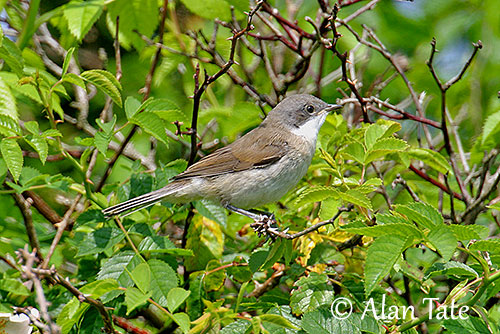
Fr: Fauvette babillarde
Ang: Lesser Whitethroat
All: Klappergrasmücke
Esp: Curruca Zarcerilla
Ita: Bigiarella
Nd: Braamsluiper
Sd: Ärtsångare
Photographers:
John Anderson
John Anderson Photo Galleries
Didier Buysse
Vision d’Oiseaux
Paul Guillet
Photos d'Oiseaux
Otto Plantema
Trips around the world
William Price
PBase-tereksandpiper & Flickr William Price
Alan & Ann Tate
AA Bird Photography
Ingo Waschkies
Bird Photography
Text by Nicole Bouglouan
Sources:
HANDBOOK OF THE BIRDS OF THE WORLD Vol 11 by Josep del Hoyo, Andrew Elliott and David Christie - Lynx Edicions - ISBN: 849655306X
THE HANDBOOK OF BIRD IDENTIFICATION FOR EUROPE AND THE WESTERN PALEARCTIC by Mark Beaman, Steve Madge - C. Helm - ISBN: 0713639601
THE COMPLETE BOOK OF BRITISH BIRDS – Written by “Royal Society for the Protection of Birds” experts - Préface de Magnus Magnusson - Michael Cady- Rob Hume Editors - ISBN: 0749509112
BIRDS OF THE MIDDLE EAST by R.F. Porter, S. Christensen, P Schiermacker-Ansen C.Helm - ISBN: 0713670169
Identification of Siberian and other forms of Lesser Whitethroat
THE FUNCTION OF SONG FORMS IN THE LESSER WHITETHROAT SYLVIA CURRUCA
Lesser Whitethroat: the bird profiles
What Bird-The ultimate Bird Guide (Mitchell Waite)
Wikipedia, the free encyclopaedia
Lesser Whitethroat
Curruca curruca
Passeriformes Order – Sylviidae Family
INTRODUCTION:
The Lesser Whitethroat is a long-distance migrant which breeds in temperate Europe (except SW) and in Western and Central Palearctic. It winters in Africa, South of the Sahara, but also in the Middle East. Three subspecies share the large range.
The Lesser Whitethroat is a typical Old World warbler of family Sylviidae. It frequents semi-open habitats, forest edges near open areas, and cultivated landscapes with some hedges or tree patches. This species is primarily an insect-eater, especially during the breeding period. Both adults share the nesting duties.
The Lesser Whitethroat is described as widespread and relatively common throughout most of the range. It is affected by habitat loss, but despite some declines in W Europe, the species is not globally threatened.

DESCRIPTION OF THE BIRD:
Biometrics:
Length: 12,5-14 cm
Wingspan: 18-19 cm
Weight: 10-16 g
The Lesser Whitethroat has greyish-brown appearance. The nominate race has greyish-washed olive-brown upperparts, including the upperwing. The tail is darker, and the outer rectrices have white edges and narrow tips.
On the whitish underparts, chin and throat are pure white. We can see a pale grey to pinkish-brown wash on body sides, whereas breast sides and vent are more buffish. This pattern forms a conspicuous central, white patch. The undertail is off white.
The head is grey with blackish-grey facial mask. An indistinct white stripe is sometimes visible over the eye. The rear nape is duller.
The bill is greyish. The eyes are dark brown. Legs and feet are grey.
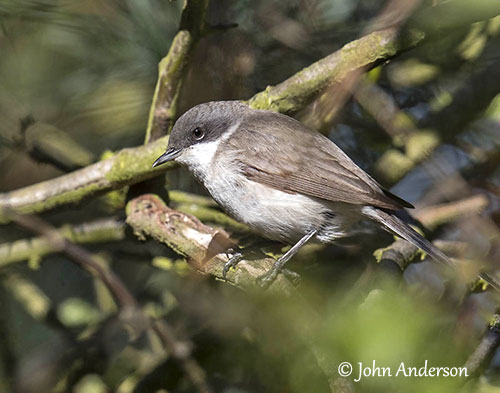
The Lesser Whitethroat differs from the Common Whitethroat by lack of rufous in wings and pale legs. The eyes are darker without white eyering or only a broken one.
Male and female are similar.
The juvenile is browner than adults, with less contrasting ear-coverts. The eyes are dark grey.
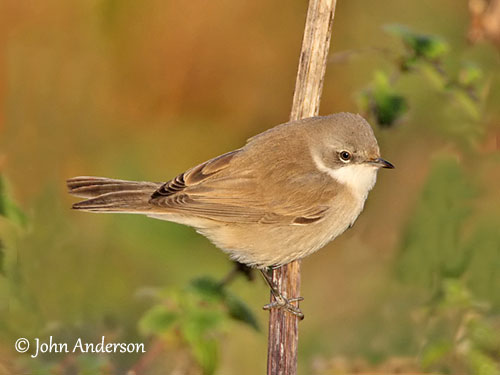
SUBSPECIES AND RANGE:
The Lesser Whitethroat has three subspecies.
C.c. curruca (described above) breeds in Europe, E to the Urals, S to N Italy, Balkans, Asia Minor, Levant, the Caucasus and NW and SW Iran. It winters in C and NE Africa, and also in the Middle East.
C.c. blythi breeds in boreal forest from the Urals, E to Transbaikalia, S to N Altai, N Mongolia and S Siberia. It probably winters in NE Africa, the Middle East and S Asia.
This race has warmer brown mantle and wings in fresh plumage, with sandy-ginger wash to tertials. The underparts are whiter with less contrast between throat and breast.
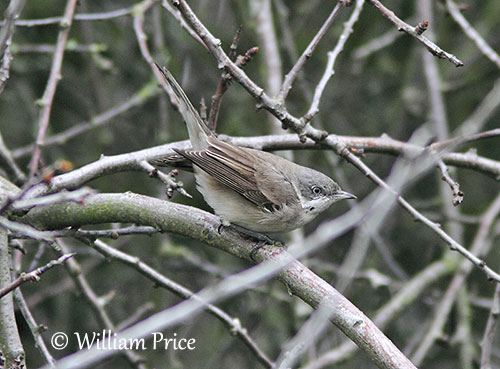
C.c. halimodendri breeds in Kazakhstan, E to W Mongolia and S to SE Caspian region, E Iran, W Afghanistan, N Tien Shan and extreme NW China. It winters mainly in Arabia, S Asia and probably NE Africa.
This race has brownish, sandy-tinged upperparts, paler than nominate. Flight-feathers and rectrices are pale brownish with pale edges on outer webs, and pale tips to secondaries. The crown is greyish and contrasts with the upperparts.
HABITAT:
The Lesser Whitethroat is found in a variety of bushy areas such as large gardens, parks, heathland, woodland edges and clearings, hedges and cultivated areas with bushy patches and some trees.
The race Halimodendri occurs in more arid habitats, steppes with scrubs and low bushes.
The Lesser Whitethroat winters in open savanna with some bushes and trees, palm groves, thickets along water, and especially strands of Tamaris and Acacia species.
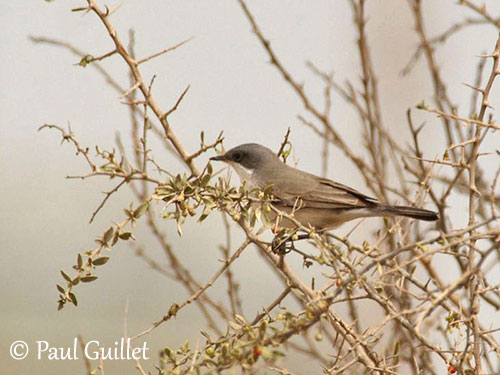
CALLS AND SONGS: SOUNDS BY XENO-CANTO
All races have the same type of call described as a dry, sharp, short “kek” or “tick” freely repeated. The alarm call is a short “churr”.
The Northern races give a dry, rapid, almost metallic rattle, preceded by a weak, short warbler.
The song consists of two parts, first a brief chatter and then, a fast, loud rattle “chakakakakaka”. But the song varies between both races and individuals.
The birds often sing from within thick vegetation or from tree canopy, rarely in flight.
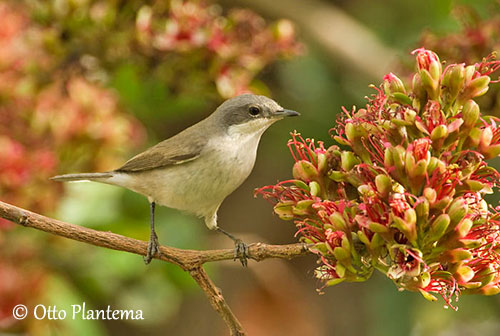
BEHAVIOUR IN THE WILD:
During the breeding season, the Lesser Whitethroat feeds primarily on various invertebrates such as flies, ants, beetles and caterpillars. It also consumes nectar.
Outside this period, especially in autumn, it feeds on berries including elderberries and blackberries. In the fall, the young birds can be seen in gardens searching for insects in bushes or eating berries.
The Lesser Whitethroat feeds in canopy of shrubs and small trees, rather than skulking in ground-level scrub like numerous other Sylviidae species. The prey are rarely caught in flight.
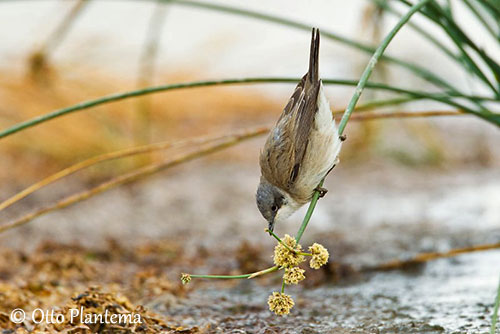
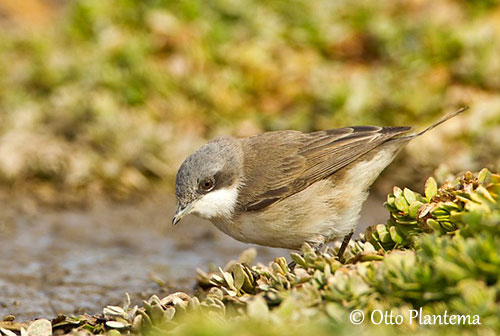
The Lesser Whitethroat is monogamous, territorial and solitary nester. At the beginning of the breeding season, the male sings loudly and frequently during the pre-fertile period, but then, the song activity declines abruptly. Most males do not sing when their female is fertile, probably to protect her from rivals.
In order to attract a female, the male builds a simple platform, sometimes several ones, but these structures are not used as “true nest”, although one of them may be used later to build the nest where the young will be raised. Both adults share all the nesting duties.
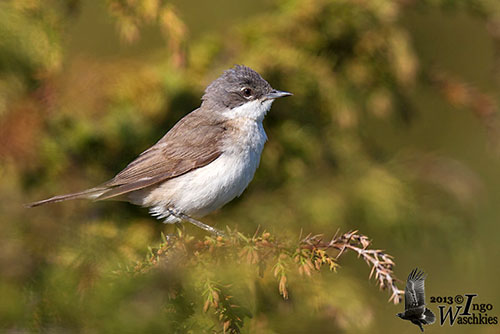
The Lesser Whitethroat is a long-distance migrant. It leaves the breeding grounds from mid-July, but mainly late August to early September. It reaches the winter quarters by late October.
The return may begin in late January or late February, but mainly from March to early April. It arrives on the breeding grounds from mid-April, but mostly in May in N of the range.
The males usually arrive 5-10 days before the females.
The Lesser Whitethroat alternates several rapid wingbeats with wings pulled to sides while flying.
In flight, it shows less white in outer tail feathers than the Common Whitethroat.
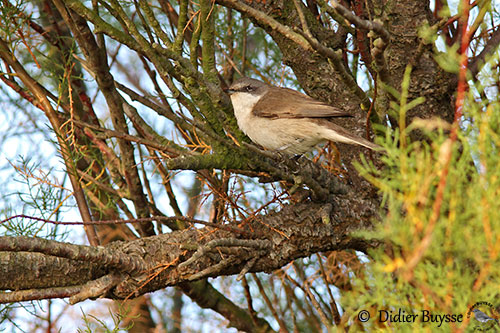
REPRODUCTION OF THIS SPECIES:
The breeding season takes place from late April to early August, two weeks earlier in C Europe than in Northern regions.
This species produces a single brood per season, rarely two.
The Lesser Whitethroat is monogamous. It is solitary nester and territorial during the breeding season.
Following displays by male, both mates build the cup-shaped nest with grass, rootlets and small twigs, but also moss, spider webs and cocoons. The cup is lined with hair and fine grass. It is built near the ground to up to 3 metres above the ground. It is placed in thorny bush, shrub or small tree, occasionally in grassy vegetation.
The female lays 3-7 white eggs with grey or olive blotches. A replacement clutch is laid if the first is lost. Both adults incubate during 11-12 days. The chicks are fed by both parents. They leave the nest 12-13 days after hatching, but they still depend on parents for food during about three weeks. They leave the natal area at 45-55 days old.
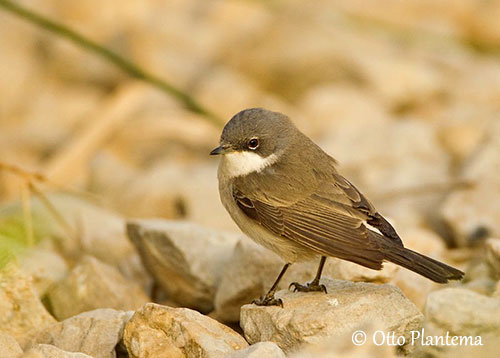
PROTECTION / THREATS / STATUS:
The Lesser Whitethroat is described as widespread and relatively common throughout the large breeding range.
The species is threatened by intensification of modern agricultural techniques, involving habitat loss. The species is declining in W Europe.
A very preliminary estimate of the global population size is 21,300,000/35,500,000 mature individuals. But more information is needed.
The overall European trend is stable (1980-2013).
The Lesser Whitethroat is not globally threatened and currently, the species is evaluated as Least Concern.
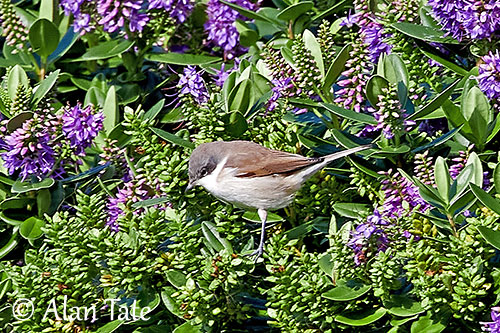
Possibly the race C.c. halimodendri
Qatar - April 2008